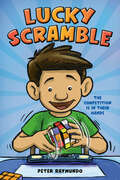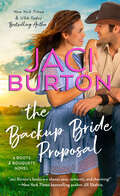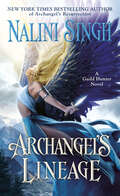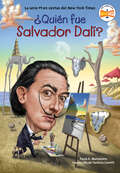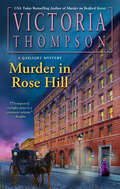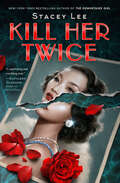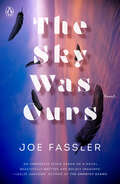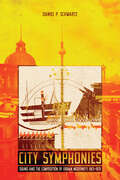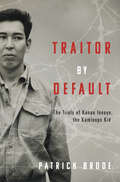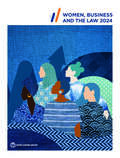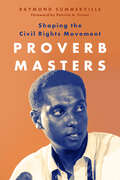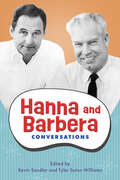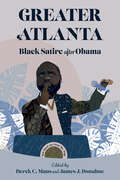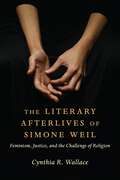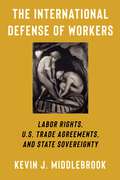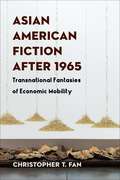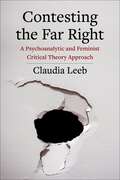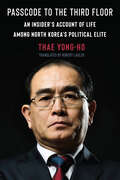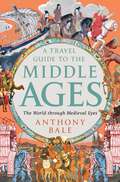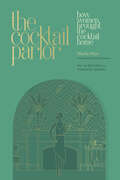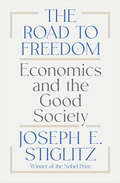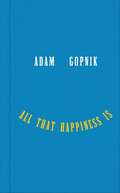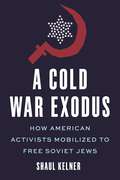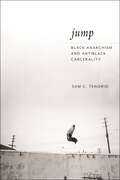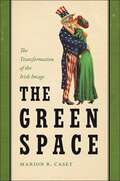- Table View
- List View
Lucky Scramble
by Peter RaymundoSix competitive cubers face off at the Speed Cubing national championships in this graphic novel that's perfect for fans of Roller Girl and the Last Kids on Earth series.Despite qualifying for the Speed Cubing National Championships in Las Vegas, twelve-year-old Tyler Goodman and his mom don&’t have the money to get him there. That is, until the retailer CubeMania offers him one of their coveted all-expenses-paid sponsorships! But getting to Vegas is just the beginning: There are hundreds of speed cubers from around the country, and each has something to prove. Like Dirk, who's certain he's about to nab his third straight National Championship trophy. Lizzy and Izzy Peterson, twins who crush cubing competitions with the exact same moves and times—until one of them decides to break the mold. Renowned eight-year-old prodigy Eli Newton solved his first puzzle cube at five, yet his dad seems much more excited about the sport and there&’s something . . . off about his cubes. And then there&’s Miles Oldman, the first American to solve the cube in under 40 seconds, who&’s back decades later to set some new records. As Lucky Scramble moves with lightning speed between the stories of these six contestants—plus that of CubeMania&’s founder and CEO Victor Chen—puzzle cube devotees and fans of graphic novels alike won&’t be able to resist racing through the pages until the very last cube has been solved.
The Backup Bride Proposal (A Boots and Bouquets Novel #4)
by Jaci BurtonThe next installment in the bestselling Boots and Bouquets series from New York Times bestselling author Jaci BurtonBellini Weddings has agreed to allow a production company to film a movie at Red Moss Vineyards. It will be great PR for both the vineyard and the wine and wedding businesses. Mae Wallace, who works for the Bellini family, is thrilled with the possibility of new business. What she isn&’t thrilled with is actor Kane August, who she finds crashing one of the weddings. He tells her it&’s research for the movie, but she finds him overconfident and annoying.Kane August is rarely surprised by anything—until he meets Mae Wallace. She&’s sharp, just a bit on the snarky side, and the most refreshing woman he&’s had the pleasure of meeting. She constantly challenges him, and he can&’t remember having this much fun on a movie set. He takes every opportunity to spend time with her, peeling back layers until he gets to the heart of who this amazing person really is. And, unexpectedly, he realizes that he&’s letting her in, too, something he hasn&’t done with anyone before. However, they live very different lives and he&’ll need to be careful around Mae, because she&’s someone he could see a future with. But can she see the same thing?When Kane takes her to his family&’s ranch in Texas, Mae discovers a whole new side to him, learning about the heart and soul of a kind and gentle man. And as they grow closer, her guard goes up. Once burned, she has no intention of falling in love ever again, despite this very hot and sexy guy who&’s trying his best to turn her world upside down and work his way through the steely wall she&’s built. Kane is determined to show her he&’s the one man she can trust with her heart. If only Mae will allow herself to fall.
Archangel's Lineage (A Guild Hunter Novel #16)
by Nalini SinghNew York Times bestselling author Nalini Singh&’s dangerous and beautiful world of archangels, vampires, and mortals has never faced a threat this cataclysmic… Raphael and Elena are experiencing their first ever year of true peace. No war. No horrors of archangelic power. No nightmares given flesh. Until…the earth beneath the Refuge begins to tremble, endangering not only angelkind&’s precious and fragile young, but the very place that has held their most innocent safe for eons. Amid the chaos, Elena&’s father suffers a violent heart attack that threatens to extinguish their last chance to heal the bonds between them and make sense of the ruins of their agonizing shared history. Even as Elena battles grief, Raphael is torn from her side by the sudden disappearance of an archangel. But worse yet is to come. An Ancestor, an angel unlike any other, stirs from his Sleep to warn the Cadre of a darkness so terrible that it causes empires to fall and civilizations to vanish.This time, even the Cadre itself may not be able to stop a ticking clock that is counting down at frightening speed…
¿Quién fue Salvador Dalí? (¿Quién fue?)
by Paula K. Manzanero Who HQLearn about the fascinating career of surrealist Salvador Dalí from his early life in Spain through his public life as an internationally famous artist in this exciting addition to the #1 New York Times Best-Selling series.Conoce la fascinante carrera del surrealista Salvador Dalí, desde sus primeros años en España hasta su vida pública como artista de fama internacional, en este nuevo libro de la serie número uno en ventas del New York Times.Most famous for his surrealist painting The Persistence of Memory and its melting clocks, Salvador Dalí combined his dreamlike ideas with his excellent technical skills to become one of the most famous artists of the twentieth century. Beyond painting, Dalí pursued the arts in many other mediums including sculpture, film, fashion, photography, architecture, and more. He was friends with many of his famous contemporaries, including Picasso, Bunuel, Miro, and Duchamp. Learn about the sometimes-shy man with the instantly recognizable upturned mustache in this book for young readers that details the life of one of modern art's most celebrated figures.Más famoso por su pintura surrealista La persistencia de la memoria y sus relojes derretidos, Salvador Dalí combinó sus ideas oníricas con sus excelentes habilidades técnicas para convertirse en uno de los artistas más famosos del siglo XX. Más allá de la pintura, Dalí se dedicó a las artes en muchos otros medios, como la escultura, el cine, la moda, la fotografía, la arquitectura y más. Era amigo de muchos de sus contemporáneos famosos, incluidos Picasso, Buñuel, Miró y Duchamp. Aprende sobre el hombre a veces tímido, con un bigote reconocible al instante, en este libro para lectores jóvenes que detalla la vida de una de las figuras más célebres del arte moderno.
Murder in Rose Hill (A Gaslight Mystery #27)
by Victoria ThompsonMidwife Sarah Malloy and her private detective husband Frank discover that the cure is worse than the disease when they investigate the death of a promising young woman in this atmospheric, riveting mystery from the USA TODAY bestselling author of Murder on Bedford Street. Sarah Malloy has just helped with the delivery of a bouncing baby girl at her women&’s clinic, when she receives a visit from an engaging and determined young woman writing an article for New Century Magazine. Louisa Rodgers explains that she is researching the dangers of patent remedies. Sarah is only too happy to tell Louisa exactly what she thinks of the so-called medicines whose ingredients include heavy doses of alcohol and other addictive drugs, and hurt much more than they help. A few days later, Sarah receives a visit from a bereft Bernard Rodgers, who explains that his daughter, Louisa, has been found strangled in the lobby of the building where New Century has its offices. The police have decided it was a random attack and have made no attempt to investigate, hinting that Louisa got what she deserved for sticking her nose where it didn&’t belong. Sarah wants justice for the bright young woman but as she and Frank delve deeper into Louisa&’s life, they find that nothing is quite as it seemed and Louisa is not who she claimed to be. The Malloys must first solve the mystery of Louisa&’s life before they can figure out who wanted to see her dead…
Kill Her Twice
by Stacey LeeFrom the New York Times bestselling author of The Downstairs Girl comes a YA murder mystery noir set in 1930s Los Angeles&’s Chinatown.&“A captivating and crackling noir full of suspenseful twists. Readers will fall in love with the Chow sisters and their quest for the truth.&” —Kathleen Glasgow, #1 New York Times bestselling author of Girl in Pieces and The AgathasLOS ANGELES, 1932: Lulu Wong, star of the silver screen and the pride of Chinatown, has a face known to practically everyone, especially the Chow sisters—May, Gemma, and Peony—Lulu&’s former classmates and neighbors. So the girls instantly know it&’s Lulu when they discover a body one morning in an out-of-the-way stable, far from the Beverly Hills home where she lived after her fame skyrocketed.The sisters suspect Lulu&’s death is the result of foul play, but the police don&’t seem motivated to investigate. Even worse, there are signs that point to a cover-up, and powerful forces in the city want to frame the killing as evidence that Chinatown is a den of iniquity and crime, even more reason it should be demolished to make room for the construction of a new railway depot, Union Station.Worried that neither the police nor the papers will treat Lulu fairly—no matter her fame and wealth—the sisters set out to solve their friend&’s murder themselves, and maybe save their neighborhood in the bargain. But with Lulu&’s killer still on the loose, the girls&’ investigation just might put them square in the crosshairs of a cold-blooded murderer.
The Sky Was Ours: A Novel
by Joe Fassler&“An immersive fever dream of a novel, beautifully written and boldly imagined.&” —Leslie Jamison, New York Times bestselling author of The Empathy ExamsFrom prizewinning writer Joe Fassler comes a brilliant modern reimagining of the myth of Daedalus and Icarus as a story of obsession, longing, and the radical pursuit of utopiaIt&’s 2005, and 24-year-old Jane is miserable. Overworked, buried in debt, she senses the life she wanted slipping away—while the world around her veers badly off course, hurtling toward economic and ecological collapse. She wants to find something better. But she has no idea where to start. In a sudden and unprecedented burst of rebellion, Jane decides to abandon everything she knows, leaving behind her relationships and responsibilities to go on the road. That&’s how she meets Barry, a brilliant and charismatic recluse living on an isolated homestead near New York&’s Canadian border. For years, in secret, Barry&’s chased an unlikely obsession: to build a pair of wings humans can fly in, with designs inspired by an obscure precursor to the Wright Brothers. It&’s no mere hobby. He&’s convinced his dream of flight will spark a revolution, delivering us from the degradation of modern capitalism and the climate chaos that awaits us. Jane is captivated by Barry&’s radical vision, even as his experiments become more dangerous. But she&’s equally drawn to the enigmatic Ike, Barry&’s gentle, thoughtful son, who&’s known no other reality—and who only wants to keep his father alive, tethered to ground and to reason. So begins an inventive, dazzlingly beautiful story about the human desire for transcendence—our longing to escape the mundane and glide into a euphoric future. Inspired by the myth of Daedalus and Icarus, The Sky Was Ours is a powerful and imaginative debut that explores the question: If you had access to technology that allowed you to escape the confines of your life, would you use it? And if Barry&’s wings really could change the world, would that be freedom?
City Symphonies: Sound and the Composition of Urban Modernity, 1913–1931
by Daniel P. SchwartzCinema scholars categorize city symphony films of the 1920s and early 1930s as a subgenre of the silent film. Defined in visual terms, the city symphony organizes the visible elements of urban experience according to musical principles such as rhythm and counterpoint.In City Symphonies Daniel Schwartz explores the unheard sonic dimensions of these ostensibly silent films. The book turns its ear to the city symphony as an audible phenomenon, one that encompasses a multitude of works beyond the cinema, such as musical compositions, mass spectacles, radio experiments, and even paintings. What these works have in common is their treatment of the city as a medium for sound. The city is neither background nor content; rather, it is the material through which avant-garde works express themselves. In resonating through the city, these multimedia pieces perform experiments that undermine the borders between sight and sound.Applying an interdisciplinary approach, City Symphonies expands our understanding of the genre, breaking out of the confines of the cinema and onto the street.
Traitor By Default: The Trials of Kanao Inouye, the Kamloops Kid
by Patrick BrodeAt the end of World War II, a young Japanese Canadian would stand trial and face execution for having committed war crimes and betraying his country.One of the most bizarre stories to emerge at the end of the Second World War was that of Kanao Inouye. Born in Kamloops, B.C., in 1916, he had relocated to his ancestral homeland of Japan, and by 1942 was a translator for the Japanese army. He was assigned to the prisoner of war camp in Hong Kong where he became infamous as one of the “most sadistic guards” over the Canadian survivors of the Battle of Hong Kong. Scores of prisoners would attest to his brutality administered in revenge for the treatment he had received growing up in Canada.His reputation was such that he was quickly apprehended after the war and faced charges of war crimes. But his subsequent trials became mired in questions as to who he really was. Was he a Canadian forced to serve in the Japanese military machine? Or was he a devoted soldier of his emperor obeying his superiors?
Women, Business and the Law 2024 (Women, Business and the Law)
by World BankWomen, Business and the Law 2024 is the 10th in a series of annual studies measuring the enabling conditions that affect women’s economic opportunity in 190 economies. To present a more complete picture of the global environment that enables women’s socioeconomic participation, this year Women, Business and the Law introduces two new indicators—Safety and Childcare—and presents findings on the implementation gap between laws (de jure) and how they function in practice (de facto). This study presents three indexes: (1) legal frameworks, (2) supportive frameworks (policies, institutions, services, data, budget, and access to justice), and (3) expert opinions on women’s rights in practice in the areas measured. The study’s 10 indicators—Safety, Mobility, Workplace, Pay, Marriage, Parenthood, Childcare, Entrepreneurship, Assets, and Pension—are structured around the different stages of a woman’s working life. Findings from this new research can inform policy discussions to ensure women’s full and equal participation in the economy. The indicators build evidence of the critical relationship between legal gender equality and women’s employment and entrepreneurship. Data in Women, Business and the Law 2024 are current as of October 1, 2023. wbl.worldbank.org
Proverb Masters: Shaping the Civil Rights Movement
by Raymond SummervilleIn Proverb Masters: Shaping the Civil Rights Movement, author Raymond Summerville explores how proverbs and proverbial language played a significant role in the long civil rights era. Proverbs have been used throughout history to share and disseminate brief, powerful statements of truth and philosophical insight. Oftentimes, these sayings have helped unite people in struggles for social justice, serving as rallying cries for just causes. During the civil rights era, proverbs allowed leaders to craft powerful and evocative messages. These statements needed to be made implicitly, as explicit messages were often met with retaliation and even violence.Looking at the autobiographies, biographies, speeches, diaries, letters, and critical texts of Charles W. Chesnutt, Ida B. Wells, A. Philip Randolph, Bob Dylan, Malcom X, Stokely Carmichael, and Septima Clark, the volume analyzes how these figures employed proverbs in support of social justice causes and in civil rights struggles. Summerville argues that these individuals generated enough print material embedded with proverbs and proverbial language that they should be considered proverb masters. With chapters dedicated to each figure, Summerville reveals their adept uses of this powerful linguistic tool.
Hanna and Barbera: Conversations (Television Conversations Series)
by Kevin Sandler and Tyler Solon WilliamsHanna and Barbera: Conversations presents a lively portrait of Bill Hanna and Joe Barbera, the influential producers behind Tom and Jerry, the Flintstones, Scooby-Doo, the Smurfs, and hundreds of other cartoon characters who continue to entertain the world today. Encompassing more than fifty years of film and television history, the conversations in this volume include first-person accounts by the namesakes of the Hanna-Barbera studio as well as recollections by artists and executives who worked closely with the pair for decades. It is the first collection of its kind about Hanna and Barbera, likely the most prolific animation producers of the twentieth century, whose studio once outflanked its competitor Walt Disney in output and influence.Bill Hanna fell into animation in 1930 at the Harman-Ising studio in Los Angeles, gaining skills across the phases of production as MGM opened its animation studio. Joe Barbera, a talented and sociable artist, entered the industry around the same time at the wild and woolly Van Beuren studio in Manhattan, learning the ins and outs of animation art before crossing the country to join MGM. In television, Hanna’s timing and community-oriented work ethic along with Barbera’s knack for sales and creating funny characters enabled Hanna-Barbera to build a roster of beloved cartoon series. A wide range of pieces map Hanna and Barbera’s partnership, from their early days in Hollywood in the 1930s to Cartoon Network in the 1990s, when a new generation took the reins of their animation studio. Relatively unknown when they made over one hundred Tom and Jerry theatrical cartoons at MGM in the 1940s and 1950s, Hanna and Barbera became household names upon entering the new medium of television in 1957. Discussions here chart their early primetime successes as well as later controversies surrounding violence, overseas production, and the lack of quality in their Saturday morning cartoons. With wit, candor, insight, and bravado, Hanna and Barbera: Conversations reflects on Bill and Joe’s breakthroughs and shortcomings, and their studio’s innovations and retreads.
Greater Atlanta: Black Satire after Obama
by Derek C. Maus and James J. DonahueContributions by GerShun Avilez, Lola Boorman, Thomas Britt, John Brooks, Phillip James Martinez Cortes, Derek DiMatteo, Tikenya Foster-Singletary, Alexandra Glavanakova, Erica-Brittany Horhn, Matthias Klestil, Abigail Jinju Lee, Derek C. Maus, Danielle Fuentes Morgan, Derek Conrad Murray, Kinohi Nishikawa, Sarah O'Brien, Keyana Parks, and Emily Ruth RutterThe seventeen essays in Greater Atlanta: Black Satire after Obama collectively argue that in the years after the widespread hopefulness surrounding Barack Obama’s election as president waned, Black satire began to reveal a profound shift in US culture. Using the four seasons of the FX television show Atlanta (2016–22) as a springboard, the collection examines more than a dozen novels, films, and television shows that together reveal the ways in which Black satire has developed in response to contemporary cultural dynamics. Contributors reveal increased scorn toward self-proclaimed allies in the existential struggle still facing African Americans today.Having started its production within a few weeks of Donald Trump’s (in)famous escalator ride in 2015, Atlanta in many ways is the perfect commentary on the absurdities of the contemporary cultural moment. The series exemplifies a significant development in contemporary Black satire, which largely eschews expectations of reform and instead offers an exasperated self-affirmation that echoes the declaration that Black Lives Matter.Given anti-Black racism’s lengthy history, overt stimuli for outrage have predictably commanded African American satirists’ attention through the years. However, more recent works emphasize the willful ignorance underlying that history. As the volume shows, this has led to the exposure of performative allyship, virtue signaling, slacktivism, and other duplicitous forms of purported support as empty, oblivious gestures that ultimately harm African Americans as grievously as unconcealed bigotry.
The Literary Afterlives of Simone Weil: Feminism, Justice, and the Challenge of Religion (Gender, Theory, and Religion)
by Cynthia R. WallaceThe French philosopher-mystic-activist Simone Weil (1909–1943) has drawn both passionate admiration and scornful dismissal since her early death and the posthumous publication of her writings. She has also provoked an extraordinary range of literary writing focused on not only her ideas but also her person: novels, nonfiction, and especially poetry. Given the challenges of Weil’s ethic of self-emptying attention, what accounts for her appeal, especially among women writers?This book tells the story of some of Weil’s most dedicated—and at points surprising—literary conversation partners, exploring why writers with varied political and religious commitments have found her thought and life so resonant. Cynthia R. Wallace considers authors who have devoted decades of attention to Weil, such as Adrienne Rich, Annie Dillard, and Mary Gordon, and who have written poetic sequences or book-length verse biographies of Weil, including Maggie Helwig, Stephanie Strickland, Kate Daniels, Sarah Klassen, Anne Carson, and Lorri Neilsen Glenn. She illuminates how writing to, of, and in the tradition of Weil has helped these writers grapple with the linked harms and possibilities of religious belief, self-giving attention, and the kind of moral seriousness required by the ethical and political crises of late modernity. The first book to trace Weil’s influence on Anglophone literature, The Literary Afterlives of Simone Weil provides new ways to understand Weil’s legacy and why her provocative wisdom continues to challenge and inspire writers and readers.
The International Defense of Workers: Labor Rights, U.S. Trade Agreements, and State Sovereignty (Woodrow Wilson Center Series)
by Kevin J. MiddlebrookInternational trade agreements have often been criticized for limited attention to the rights of workers. The North American Agreement on Labor Cooperation (NAALC), a side agreement to the North American Free Trade Agreement (NAFTA), stands out for linking labor rights provisions to a U.S. trade agreement. Kevin J. Middlebrook provides a comprehensive and systematic examination of the NAALC, assessing its efficacy in protecting workers’ rights over the entire period it was in effect and demonstrating its broader significance for the role of trade and labor standards in U.S. foreign policy.Placing the NAALC in comparative context, Middlebrook considers various ways of promoting workers’ rights and how other U.S. international trade agreements have influenced labor rights abroad. He investigates the origins of the agreement; the political controversies among Canada, Mexico, and the United States over its scope; how the agreement operated in practice; and its longer-term policy legacies. Middlebrook emphasizes the tension between state sovereignty and the international promotion of labor rights in the negotiation and implementation of trade agreements, as well as how labor movements in one partner country can galvanize action in others.Drawing on interviews with high-level officials involved in the trade negotiations and previously unexamined primary sources, The International Defense of Workers is a groundbreaking analysis of the effects of U.S. trade agreements on labor rights.
Asian American Fiction After 1965: Transnational Fantasies of Economic Mobility
by Christopher T. FanAfter the 1965 Immigration and Nationality Act loosened discriminatory restrictions, people from Northeast Asian countries such as South Korea, Taiwan, Japan, and eventually China immigrated to the United States in large numbers. Highly skilled Asian immigrants flocked to professional-managerial occupations, especially in science, technology, engineering, and math. Asian American literature is now overwhelmingly defined by this generation’s children, who often struggled with parental and social expectations that they would pursue lucrative careers on their way to becoming writers.Christopher T. Fan offers a new way to understand Asian American fiction through the lens of the class and race formations that shaped its authors both in the United States and in Northeast Asia. In readings of writers including Ted Chiang, Chang-rae Lee, Ken Liu, Ling Ma, Ruth Ozeki, Kathy Wang, and Charles Yu, he examines how Asian American fiction maps the immigrant narrative of intergenerational conflict onto the “two cultures” conflict between the arts and sciences. Fan argues that the self-consciousness found in these writers’ works is a legacy of Japanese and American modernization projects that emphasized technical and scientific skills in service of rapid industrialization. He considers Asian American writers’ attraction to science fiction, the figure of the engineer and notions of the “postracial,” modernization theory and time travel, and what happens when the dream of a stable professional identity encounters the realities of deprofessionalization and proletarianization. Through a transnational and historical-materialist approach, this groundbreaking book illuminates what makes texts and authors “Asian American.”
Contesting the Far Right: A Psychoanalytic and Feminist Critical Theory Approach (New Directions in Critical Theory #88)
by Claudia LeebWhy have so many people responded to the insecurity, exploitation, alienation, and isolation of precarity capitalism by supporting the far right? In this timely book, Claudia Leeb argues that psychoanalytic and feminist critical theory illuminates how economic and psychological factors interact to produce this extreme political shift.Contesting the Far Right examines right-wing recruitment tactics in the United States and Austria, where people discontented with the status quo have turned to far-right parties and movements that further cement capitalism’s adverse effects. Leeb contends that Freudian psychoanalytic theory and early Frankfurt School Critical Theory provide analytical tools to explain this apparent contradiction in psychological terms. Living under precarity capitalism generates feelings of failure and anxiety, which people experience as non-wholeness, because it has become difficult if not impossible to live up to the fetish of economic, interpersonal, and bodily success, and the far right preys on such feelings. Its psychologically oriented propaganda tactics produce the illusion of wholeness and a positive sense of self while leaving the socioeconomic conditions that cause people’s suffering intact. At the same time, they remove the inhibitions that keep people’s repressed aggression and racist and sexist attitudes in check. To demonstrate the workings of this process, Leeb compares cases including Trump and the alt-right in the United States and the Freedom Party and the identitarian movement in Austria. At once theoretically rich and politically engaged, this book also offers ways to resist the far right and counter the psychological appeal of its propaganda techniques.
Passcode to the Third Floor: An Insider's Account of Life Among North Korea's Political Elite
by Thae Yong-hoThae Yong-ho was a leading North Korean diplomat to the United Kingdom and Northern Europe—until his dramatic defection to South Korea in 2016. In this gripping tell-all, he reveals the inner workings of the North Korean regime and shares the story of his decision to leave.Thae spent nearly three decades working under three generations of the ruling Kim dynasty after entering the foreign service as an idealistic twenty-seven-year-old “red warrior” eager to strive for the “socialist motherland.” During this time, he witnessed the arbitrary and tyrannical rule of the Kim family and the enigmatic “Third Floor,” a powerful group of high-ranking officials. Thae provides up-close portraits of the excesses of the North Korean elite and the depths of the cult of personality around the Kims, describing experiences such as concocting reports of Europeans celebrating the birthdays of Kim Il-sung or Kim Jong-il and escorting Kim Jong-un’s older brother to Eric Clapton concerts in London. He also details the economic and political consequences of North Korea’s pursuit of the bomb and the immiseration of the vast majority of the population.Today a politician in South Korea who advocates unification, Thae offers a powerful plea for the families torn apart by the conflict—including his own, as his brother and sister likely now languish in prison camps. A best-seller in South Korea, Passcode to the Third Floor is an unparalleled look at North Korean politics and diplomacy, giving readers intimate access to the regime’s innermost secrets.
A Travel Guide to the Middle Ages: The World Through Medieval Eyes
by Anthony BaleA captivating journey of the expansive world of medieval travel, from London to Constantinople to the court of China and beyond. Europeans of the Middle Ages were the first to use travel guides to orient their wanderings, as they moved through a world punctuated with miraculous wonders and beguiling encounters. In this vivid and alluring history, medievalist Anthony Bale invites readers on an odyssey across the medieval world, recounting the advice that circulated among those venturing to the road for pilgrimage, trade, diplomacy, and war. Journeying alongside scholars, spies, and saints, from Western Europe to the Far East, the Antipodes and the ends of the earth, Bale provides indispensable information on the exchange rate between Bohemian ducats and Venetian groats, medieval cures for seasickness, and how to avoid extortionist tour guides and singing sirens. He takes us from the streets of Rome, more ruin than tourist spot, and tours of the Khan’s court in Beijing to Mamluk-controlled Jerusalem, where we ride asses across the holy terrain, and bustling bazaars of Tabriz. We also learn of rumored fantastical places, like ones where lambs grow on trees and giant canes grow fruit made of gems. And we are offered a glimpse of what non-European travelers thought of the West on their own travels. Using previously untranslated contemporaneous documents from a colorful range of travelers, and from as far and wide as Turkey, Iceland, North Africa, and Russia, A Travel Guide to the Middle Ages is a witty and unforgettable exploration of how Europeans understood—and often misunderstood—the larger world.
The Cocktail Parlor: How Women Brought the Cocktail Home
by Nicola NiceMeet the hostesses who have shaped cocktail history, and learn how to make the drinks they loved. Throughout American history, women have helped propel what we know as classic cocktails—the Martini, the Manhattan, the Old-Fashioned, and more—into popular culture. But, often excluded from private clubs, women exercised this influence from the home, in their cocktail parlors. In The Cocktail Parlor, Dr. Nicola Nice, sociologist and spirits entrepreneur, gives women their long-overdue spotlight in cocktail history and shows how they still impact cocktail culture today. Journeying through the decades, this book profiles a diverse array of influential hostesses. With each historic era comes iconic recipes, featuring a total of 40 main cocktails and more than 100 variations that readers can make at home. Whether its happy hour punch à la Martha Washington or a Harlem Renaissance–inspired Green Skirt, readers will find that many of the ingredients and drinks they’re familiar with today wouldn’t be here without the hostesses who served them first.
The Road to Freedom: Economics And The Good Society
by Joseph E. StiglitzFrom one of the world’s leading economists, a compelling new vision of personal and economic freedom. We are a nation born from the conviction that people must be free. But since the middle of the last century, that idea has been co-opted. Forces on the political Right have justified exploitation by cloaking it in the rhetoric of freedom, leading to pharmaceutical companies freely overcharging for medication, a Big Tech free from oversight, politicians free to incite rebellion, corporations free to pollute, and more. How did we get here? Whose freedom are we—and should we—be thinking about? In The Road to Freedom, Nobel prize winner Joseph E. Stiglitz dissects America’s current economic system and the political ideology that created it, laying bare their twinned failure. “Free” and unfettered markets have only succeeded in delivering a series of crises: the financial crisis, the opioid crisis, and the crisis of inequality. While a small portion of the population has amassed considerable wealth, wages for most people have stagnated. Free and unfettered markets have exploited consumers, workers, and the environment alike. Such failures have fed populist movements that believe being free means abandoning any obligations citizens have to one another. As they grow in strength, these movements now pose a real threat to true economic and political freedom. As an economic advisor to presidents and as chief economist at the World Bank, Stiglitz has witnessed these profound changes firsthand. As he argues, the failures follow from the elites’ unshakeable dedication to “the neoliberal experiment.” Explicitly taking on giants such as Friedrich Hayek and Milton Friedman, Stiglitz exposes accepted ideas about our political and economic life for what they are: twisted visions that tear at the social fabric while they enrich the very few. The Road to Freedom breaks new ground, showing how economics—including recent advances in which Stiglitz has played such an important role—reframes how to think about freedom and the role of the state in a twenty-first century society. Drawing on the work of contemporary philosophers, Stiglitz explains a deeper, more humane way to assess freedoms—one that considers with care what to do when one person’s freedom conflicts with another’s. We must reimagine our existing economic and legal systems and embrace forms of collective action, including regulation and investment, if we are to create an innovative society in which everyone can flourish. The task could not be more urgent, and Stiglitz’s latest book is essential reading for those committed to the American ideal of an economic and political system that delivers well-being, opportunity, and meaningful freedoms for all.
All That Happiness Is: Some Words on What Matters
by Adam GopnikFrom New Yorker staff writer Adam Gopnik, a slim, elegant volume presenting a radical alternative to our culture of relentless striving. Our society is obsessed with achievement. Young people are pushed toward the next test or the “best” grammar school, high school, or college they can get into. Adults push themselves toward the highest-paying, most prestigious jobs, seeking promotions and public recognition. As Adam Gopnik points out, the result is not so much a rat race as a rat maze, with no way out. Except one: to choose accomplishment over achievement. Achievement, Gopnik argues, is the completion of the task imposed from outside. Accomplishment, by contrast, is the end point of an engulfing activity one engages in for its own sake. From stories of artists, philosophers, and scientists to his own fumbling attempts to play Beatles songs on a guitar, Gopnik demonstrates that while self-directed passions sometimes do lead to a career, the contentment that flows from accomplishment is available to each of us. A book to read and return to at any age, All That Happiness Is offers timeless wisdom against the grain.
A Cold War Exodus: How American Activists Mobilized to Free Soviet Jews
by Shaul KelnerReveals the mass mobilization tactics that helped free Soviet Jews and reshaped the Jewish American experience from the Johnson era through the Reagan–Bush yearsWhat do these things have in common? Ingrid Bergman, Passover matzoh, Banana Republic®, the fitness craze, the Philadelphia Flyers, B-grade spy movies, and ten thousand Bar and Bat Mitzvah sermons? Nothing, except that social movement activists enlisted them all into the most effective human rights campaign of the Cold War.The plight of Jews in the USSR was marked by systemic antisemitism, a problem largely ignored by Western policymakers trying to improve relations with the Soviets. In the face of governmental apathy, activists in the United States hatched a bold plan: unite Jewish Americans to demand that Washington exert pressure on Moscow for change.A Cold War Exodus delves into the gripping narrative of how these men and women, through ingenuity and determination, devised mass mobilization tactics during a three-decade-long campaign to liberate Soviet Jews—an endeavor that would ultimately lead to one of the most significant mass emigrations in Jewish history.Drawing from a wealth of archival sources including the travelogues of thousands of American tourists who smuggled aid to Russian Jews, Shaul Kelner offers a compelling tale of activism and its profound impact, revealing how a seemingly disparate array of elements could be woven together to forge a movement and achieve the seemingly impossible. It is a testament to the power of unity, creativity, and the unwavering dedication of those who believe in the cause of human rights.
Jump: Black Anarchism and Antiblack Carcerality
by Sam C. TenorioAsks how we can better understand a politics of refusalWriting a new story of Black politics, Jump emerges from the practice of enslaved Africans jumping overboard off their slavers’ ships. Reading against the narrative that depoliticizes and denigrates the leaps of the enslaved as merely suicidal symptoms of chattel slavery and the Middle Passage, Sam C. Tenorio demonstrates how bringing these jumps to bear on the foundations of Black politics allows us to rethink a politics of refusal.In a period of increasing political mobilization against police brutality and mass incarceration, Jump attends to the layers of confinement that constitute the racial and gendered hierarchies of the antiblack world. Centering radical acts too often relegated to the periphery of Black politics, Tenorio proposes a Black anarchist politics of refusal that helps us to think dissent anew.Tracing iterations of the jump through the carceral wake of the slave ship, Tenorio explores the voyages of the Black Star Line in defiance of the bordered authority of the nation state, the Watts Rebellion of 1965 against the property relation of ghettoization, and Assata Shakur’s abscondence from prison to Cuba. Ultimately, Tenorio argues that considering the jump as a progenitor of Black politics deepens and widens our conceptualization of the Black radical tradition and introduces a paradigm-shifting attention to Black anarchism.
The Green Space: The Transformation of the Irish Image (The Glucksman Irish Diaspora Series)
by Marion R. CaseyA historical exploration of the Irish image in popular cultureIt only took a century or so to segue from phrases like “No Irish Need Apply” to “Kiss Me, I’m Irish” in American popular culture. Indeed, the transformation of the Irish image is a fascinating blend of political, cultural, racial, commercial, and social influences.The Green Space examines the variety of factors that contributed to remaking the Irish image from downtrodden and despised to universally acclaimed. To understand the forces that molded how people understand “Irish” is to see the matrix—the green space—that facilitated their interaction between the 1890s and 1960s. Marion R. Casey argues that, as “Irish” evolved between the mid-nineteenth and mid-twentieth centuries, a visual and rhetorical expanse for representing ethnicity was opened up in the process. The evolution was also transnational; both Ireland and the United States were inextricably linked to how various iterations of “Irish” were deployed over time—whether as a straightforward noun about a specific people with a national identity or a loose, endlessly malleable adjective only tangentially connected to actual ethnic identity.Featuring a rich assortment of sources and images, The Green Space takes the history of the Irish image in America as a prime example of the ways in which culture and identity can be manufactured, repackaged, and ultimately revolutionized. Understanding the multifaceted influences that shaped perceptions of “Irishness” holds profound relevance for examining similar dynamics within studies of various immigrant and ethnic communities in the US.
